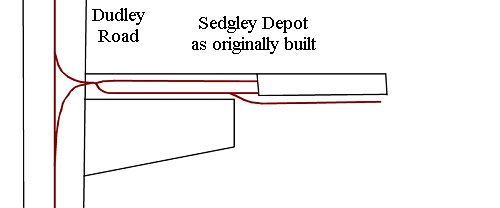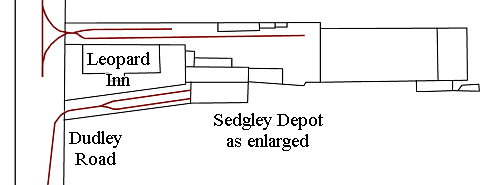|
This is the story of the first ten
years of the tramway from Wolverhampton to Dudley, which ran
from Snow Hill, Wolverhampton, past the Fighting Cocks and
up the hill to the Bull Ring in Sedgley, before travelling
through Upper Gornal to Wolverhampton Street, Dudley. It was
a difficult route, just over five miles long, with steep
gradients and narrow streets to negotiate. Three tramway
companies attempted to operate the route, but all failed,
success only coming after the British Electric Traction
Company acquired the line and converted it to electric
traction.
It began in 1879 with the formation of
the Dudley, Sedgley, and Wolverhampton Tramways Company
Limited which were given powers to build and operate the
tramway under the terms of the Tramways Orders Confirmation
(No. 1) Act, 1880. Although the company had intended to
start from the Post Office in Wolverhampton Street, Dudley,
and to run to the Agricultural Hall in Snow Hill,
Wolverhampton, the Board of Trade decided that neither
terminus was suitable. The narrowness of the road in Dudley
meant that the terminus had to be about 66 yards short of
the post office, and in Wolverhampton the terminus on
Snow Hill had to be near the Temple Street junction, around 88 yards
short of the Agricultural Hall, because of the steepness of
the road.
The company received another blow
because although it had intended to use steam traction,
it was not allowed, so horses had to be used instead.
However the company was sure that steam operation would soon
be allowed and so the track and sheds were built with this
in mind.
Work on the line began at the
Wolverhampton end in August 1881, and by July 1882 the first
three miles had been built as far as Sedgley. The
completion date was expected to be in October, and as the
local authorities were in favour of steam traction on the
line, the company assumed that an application to the Board of
Trade before the end of the year, for steam operation, would
be successful.
The first of seven cars arrived in
November, horses were purchased, and temporary stables were
rented for the duration of horse operation. The double deck
cars were built by the Ashbury Railway Carriage and Wagon
Company, and due to the gradients, had to be operated by
three horses. They were finished in a lined chocolate colour
with yellow window frames, and seats fitted with comfortable
maroon velvet cushions. A trial trip was made over the line
on 4th December, and before the month was over, Major
General Hutchinson inspected the line on behalf of the Board
of Trade. After several modifications had been
carried out, permission to operate the line was granted.

The line opened for business on Monday
7th May, 1883, but the steep gradients and narrow roads were
difficult for the horses. The journey took about one hour,
and a shuttle service was originally used with just one car,
so the tram left each terminus at two hourly intervals. By
1884 an extra car was used on the section between
Wolverhampton and the Fighting Cocks which resulted in a
half-hourly service on that part of the route, and a service
of one and three quarter hours on the remainder of the line.
The tramway did not prove to be popular because of the
infrequent service, which was costly to run.
As intended, late in 1882 the company
applied to the Board of Trade for a provisional order to run
steam on the line, which was refused because of the
narrowness of parts of the route. In 1884 the company
applied again for permission to use steam traction and
replaced the existing cars with narrower ones having a width
of five feet six inches. The plan was to use steam
locomotives of the same width. This resulted in the Dudley,
Sedgley and Wolverhampton Tramways Order, 1884 which allowed
steam tramway locomotives to be used on all but two short
narrow sections of the route, unless the roadway could be
widened.
By 1885 the company had around seven
cars, 42 to 48 horses, and was still loosing money. In
August 1885 the company was taken to court by the Inland
Revenue for using seven cars while only having licenses for
four. This resulted in a fine of five pounds.
Plans were now made for steam operation
on the line, but to the company’s dismay it was found that
the original cast iron points would have to be replaced with
steel points. The worked was carried out by Mr. John Fell,
of Leamington who also had the task of enlarging the depot
by the Leopard Inn, at Sedgley for steam engines and new
cars. Five cars and five engines were ordered, but while
work on the line progressed, it was discovered that in some
places the rails were between half, and three quarters of an
inch out of gauge, which resulted in the closure of the line
for about six weeks while the re-gauging was in progress.
The line closed on 8th November, 1885.
The tramway locomotives were built by
Kitson with inside cylinders 8½ inches by 12 inches, and the
double deck cars were built by Starbuck. All had to run on
the four feet eight and a half inch gauge, but with a maximum width
of five feet six inches, must have been difficult to
achieve.
Although Wolverhampton Council gave its
approval for steam operation on the line, Wolverhampton’s
Borough Surveyor stated that caution was needed at the Snow
Hill terminus because of the 1 in 33 down gradient. The
Board of Trade inspected the rebuilt line on 1st January,
1886, and permission was given to use steam except at the
Dudley terminus because there was not enough room to run the
engine around the car.
Operation began on 16th January, 1886,
but the company soon found itself in trouble for allowing
one of the locomotives to emit steam. At the annual general
meeting in 1886 the shareholders were told that the
introduction of steam had been successful, takings were up
by ten pounds a week, the cost of operation had been reduced
by 1.37 pence per mile, and so fares had been reduced
accordingly.

The steepness of the gradient at the
Wolverhampton terminus nearly led to disaster in November
1886 when a driver failed to restart the engine and left the
footplate to see what was wrong. The engine and car then
began to move forward gathering speed down the hill. The
driver tried to climb back on to the engine but was thrown
to the ground. Luckily the tram came to a standstill just
seventy yards from the end of the line.
The company continued to loose money
and went into liquidation in March 1888. The tramway,
including the engines and cars was sold at auction to two
contractors, Mr. E. D. Oppert and Mr. J. Fell.
On 18th October, 1889 the newly formed
Midland Tramways Company Limited purchased the complete
tramway for £44,000 in debentures and shares, and in 1890
began to operate a service. In 1992 work began on
improving the track between Wolverhampton and Sedgley.
Unfortunately the company found itself
in financial difficulty, and in early 1893 was in the hands
of a receiver. The creditors decided to reconstruct the
company with reduced capital, and to receive shares to the
amount of their debts. The new company called Dudley and
Wolverhampton Tramways Company Limited was founded in about
September 1893, the General Manager being Mr. Frank Hatch.
The tramway began to operate as before,
and at the end of 1894 another Kitson engine was purchased.
Around this time windows were added to enclose the upper
deck on each of the cars, greatly improving passengers’
comfort. After the work had been carried out, one of the
cars was blown over on the section between Sedgley and the
Fighting Cocks, during a strong gale. Afterwards one window
on each side of the upper deck was left unglazed to prevent
it happening again.
By 1897, the hourly service had been
reduced to thirty minutes on weekday mornings, and the
Sunday service started at 2 p.m. When the Board of Trade
carried out a twelve monthly inspection in November 1897,
Wolverhampton Council ceased to allow the loading and
unloading of cars on the section of the line north of George
Street, on Sundays, and expressed the hope that some
improved form of motive power would soon be introduced on
the line. Before the twelve months had expired, another
Board of Trade inspection was carried out by Sir F.
Marandin. He advised the Board not to renew the license for
steam operation until three steam engines could be made
available in really good order. All of the local
authorities, Wolverhampton, Sedgley, and Dudley had
complained about the service and objected to the renewal of
the licence.
The company managed to sufficiently
improve the engines to satisfy the inspector, and so in due
course a licence was issued. Three of the company’s engines,
which had been purchased in July 1898 were elderly second
hand locomotives from Huddersfield Corporation Tramways, and
could not have been in good condition. After the inspection,
the company only had three serviceable locomotives,
sufficient to run the bare service, and no spare, so the
situation was desperate.
By November 1898, the British Electric
Traction Company Limited had decided to purchase the
company, and an agreement was signed on 16th January, 1899.
The Dudley and Wolverhampton Tramways Company Limited went
into voluntary liquidation, and on 22nd April B.E.T.
purchased the tramway from the receiver for £18,300 with the
object of electrifying the line. Initially steam car
operation continued as before, but was soon phased out. |